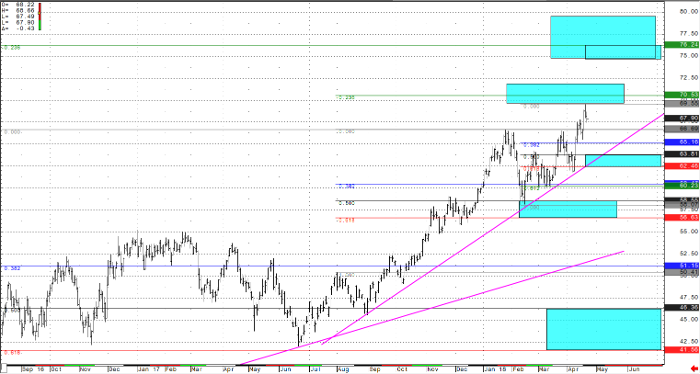
This week the EIA Petroleum Status Report continued to confirm a more bullish fundamental outlook, with crude oil stocks having drawn down -1.1 million barrels for the week of 4/13. The decrease in WTI inventories is likely a result of the strong refinery operation, with US refineries operating at 92.4% of full capacity (even though this is .9% lower than last week). As I have mentioned in the past, the $60 to $65 price per barrel threshold is significant for many (both within US, and abroad) producers. Now that WTI crude prices have broken above multi-year highs, and the psychological price barrier of $66 is likely to be tested as support. It’s worth noting that the current run up in crude prices could be the result of pipeline constraints, where US shale oil fields are having trouble moving the product to market. This is generally because pipelines are at capacity, and with pipeline expansion projects in the works, WTI producers are having to rely on the more expensive means of trucking crude from fields to refineries.
With a constraint in the ability to get oil out of production areas, the rally which broke through multi-year highs seems like confirmation of a longer term trend beginning. While it’s still early, and some conditions are starting to suggest short-term over bought conditions, traders looking to position long should begin to look for supportive levels for entry. While a Fibonacci support zone has already provided a bounce from the $58.50 to $58.00 inflection zone (blue boxes on chart are Fibonacci inflection zones), WTI crude futures have begun their climb towards these inflection zone targets clustered between $70 and $76 a barrel. If WTI crude prices break back into the multi-year range (below $65), traders can expect support into the $63.80 and $58.00 inflection zones. Either of these supportive areas would be logical downside targets if the price of WTI crude breaks lower, however, the bulls have been holding their key levels and defending their supportive levels. Before this situation can even be considered, WTI crude price would need to settle below $65.00 a barrel.
In my opinion, the rally that has taken WTI crude prices above the $66.66 continuous contract highs (into the end of 2017 and start of 2018) is still at the forefront of traders’ minds. While there are still the prior highs ($69.55) to break through, there may be an opportunity to position for the resolving push to test above $70.00 and hit those technical $76 upside targets. With WTI crude prices above prior multi-year highs, the trend is up until it’s not (and I like to think, trend is my friend). When a market speaks, you must listen, and WTI crude may be telling us this is the beginning of a much larger trend being born.
Crude Oil Daily Continuation Chart


